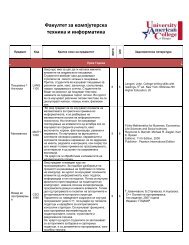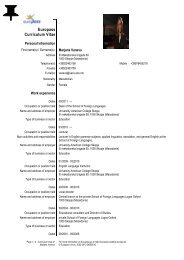INPUT-OUTPUT ANALYSIS
INPUT-OUTPUT ANALYSIS
INPUT-OUTPUT ANALYSIS
You also want an ePaper? Increase the reach of your titles
YUMPU automatically turns print PDFs into web optimized ePapers that Google loves.
PART I:Input-Output Definitions3
Input-Output Tables• Leontief took the profession by surprise andstimulated an enormous amount of empirical andtheoretical research on the subject.• To perform the test, Leontief used the 1947 inputoutputtable of the US economy.99
Paradox continued• He aggregated industries into 50 sectors, but only 38industries produced commodities that enter the internationalmarkets, and the remaining 12 sectors were created foraccounting identities and non-traded goods.• He also aggregated factors into two categories, labor andcapital. He then estimated the capital and laborrequirements to produce:• One million dollars' worth of typical exportable andimportable in 1947.1010
Paradox continued• The US seems to have been endowed withmore capital/worker than any other country in theworld in 1947.• Thus, the HO theory predicts that the US exports wouldhave required more capital per worker than US imports.• However, Leontief was surprised to discover that USimports were 30% more capital-intensive than USexports.1111
Paradox continued…• At first, Leontief was criticized on statistical grounds.• Swerling complained that 1947 was not a typical year:the postwar disorganization of production overseas wasnot corrected by that time.• In 1956 Leontief repeated the test for US imports andexports which prevailed in 1951. In his second study,Leontief aggregated industries into 192 industries. Hefound that US imports were still more capital-intensivethan US exports.• US imports were 6% more capital-intensive.1212
Explanations• Leontief himself suggested an explanation forhis own paradox. He argued that US workersmay be more efficient than foreign workers.• Perhaps U.S. workers were three times aseffective as foreign workers.1313
Higher US Productivity• It means that the average American worker isthree times as effective as he would be in theforeign country.• Given the same K/L ratio, Leontief attributedthe superior efficiency of American labor tosuperior economic organization andeconomic incentives in the U.S.1414
More than two factors• More recent tests recognize that more thantwo types of production factors are relevant.• Results for H-O are not that disappointingwhen we take more factors into consideration.1515
H-O works forsome US sectors…• In general, trade patterns fit the H-O theoryreasonably well but certainly not perfectly.• The US is relatively abundant in skilled labor, andtends to be a net exporter of products that areskilled-labor-intensive or technology-intensive,including aircraft and medical instruments.1616
Back to the definitions:Input-Output Model• An IO model is centered on the idea of inter-industrytransactions:– Industries use the products of other industries to producetheir own products.– For example - automobile producers use steel, glass,rubber, and plastic products to produce automobiles.– Outputs from one industry become inputs to another.– When you buy a car, you affect the demand for glass,plastic, steel, etc…17
Basic Input-Output LogicSteelGlassTiresPlasticOtherComponentsAutomobile Factory18
From the TireProducer’sPerspectiveTire FactoryIndividualConsumersSchoolDistrictsTruckingCompaniesFINALDEMANDFOR TIRESAutomobileFactoryINTER-MEDIATEDEMANDFORTIRES19
Input-Output Analysis‣ The implicit assumption in economic base techniques is thateach basic sector job has a multiplier (or ripple) effect onthe wider economy because of purchases of non-basic goodsand services to support the basic production activity. (thebasic sector drives the non-basic sector)‣ However, we know that non-basic sector businessespurchase non-basic goods and services and basic sectorbusinesses purchase Basic sector goods and services. Thereare inter-industry linkages not contained within a basiceconomic model (basically the multiplier model you knowfrom your intermediate macro course). The economy ismuch more complex than the economic base techniques20allow or attempt to model.
Input-Output Analysis‣ The central advantage of Input-Output analysis is that ittries to estimate these inter-industry transactions and usethose figures to estimate the economic impacts of anychanges to the economy.‣ Instead of assuming a change in a basic sector industryhaving a generalized multiplier effect, the IO approachestimates how many goods and services from other sectorsare needed (inputs) to produce each dollar of output for thesector in question. Therefore it is possible to do a muchmore precise calculation of the economic impacts of a givenchange to the economy.21
IO Conceptualization of the Economy• The major conceptual step is to divide the economy into“purchasers” and “suppliers”:--Primary Suppliers: They sell primary inputs (labor, rawmaterials) to other industries. Payments to these suppliersare “primary inputs” because they generate no furthersales. (example: Households)--Intermediate Suppliers: They purchase inputs forprocessing into outputs they supply to other firms or tofinal purchasers. (example: Automaker)22
IO Conceptualization of the Economy• The major conceptual step is to divide the economy into“purchasers” and “suppliers”:--Intermediate Purchasers: They purchase outputs of suppliersfor use as inputs for further processing. (example:Automaker)--Final Purchasers: Purchase the outputs of suppliers in theirfinal form and for final use. (example: Households)• Intermediate Suppliers and Intermediate Purchasers are thesame thing!• Primary Suppliers and Final Purchasers may or may not bethe same entities. When they are the same (households),these activities are understood as separate activities.23
Simplified Circular Flow View of The Economy$$ Consumption Spending (Yi)Goods & ServicesHouseholdsBusinessesBusinessesLaborHouseholds buythe output ofbusiness: finaldemand or Y i$$ Wages & SalariesHouseholds selllabor & otherinputs to businessas inputs toproductionBusinesses purchase fromother businesses to producetheir own goods / services.This is intermediatedemand or x ij (output ofindustry i sold to industry j)24
PART II:Input-Output Model for a Simple Economy25
Input-Output Model for a Simple Economy• Consider a simple economy with two industries:– a lumber industry– a power industry• Suppose that production of 10 units of power require 4 unitsof power and 25 units of power require 5 units of lumber.• 10 units of lumber require 1 unit of lumber and 25 units oflumber require 5 units of power.• If surplus of 30 units of lumber and 70 units of powerare desired, how much would be the gross production ofeach industry.26
Creating a Technology Matrix• First step would beconverting all numbers topercentages:• Powerpower: 4/10 = 0.4• Lumberpower: 5/25 = 0.2• Lumberlumber: 1/10 = 0.1• Powerlumber: 5/25 = 0.2OutputsInputs Power LumberPower 0.4 0.2Lumber 0.2 0.127
Creating a Technology Matrix• Now we can use thisinformation to create the socalled “technology matrix”or “Leontief matrix”.OutputsInputs Power LumberPower 0.4 0.2Lumber 0.2 0.1A.4.2.2.128
The Gross Production Matrix• The gross production matrix for the economy can berepresented by the column matrix:X• Where x1 is the gross production of power and x2 is thegross production of lumber.x1x229
The Technological Equation• X (or IX where I is the identity matrix) is the amount ofproduction that is desired.• AX is the amount of actual production.• So IX-AX=(I-A)X is the amount of surpluses, D, (alsocalled final demands).30
The Technology Equation( I A)XD• Is called the “technology equation”.31
Back to our Simple Economy• Original Question : If surplus of30 units of lumber and 70 unitsof power are desired, find thegross production of eachindustry.• In other words, what is the grossproduction which would satisfythe final demand D (70,30)?• Find XD70 30 32
Input-Output Model for a Simple Economy• To find X, take the inverse of (I-A) [if itexists]( IA)XDX( IA)1D33
34 .9.2.2.6.1.2.2.41001AI1.20.4100.41.8011.20.41001.667.33311.333.833001.667.333110.9.201.667.33311001.9.2.2.6Finding the inverse of I-A:Input-Output Model for a Simple Economy
Input-Output Model for a Simple EconomyIA100.4 1.2.2.1 .6.2.2.9 Finding the inverse of I-A (alternative way):1 .9(.6*.9) (( .2)*(.2)).2.2.61 .9.54 .04.2.2.6.92.2.2.61.8 .4.4 1.235
Input-Output Model for a Simple Economy• We found that the inverse of I-Ais:• To find the amount to producefor the desired amount ofdemand, we must multiply theinverse of I-A and D:• Hence the gross production are :– Lumber : 64 units– Power : 138 units( IXXA)( I11.8 .4A)1.8 .41D.4 1.2.4 701.2301386436
Input-Output Model for a Simple EconomyAnother Example (3x3)• The economy of a hypothetical developing country is based onagricultural products, steel, and coal.• An input of 1 ton of agricultural products requires an input of 0.1 tonof agricultural products, 0.02 ton of steel, and 0.05 ton of coal.• An output of 1 ton of steel requires an input of 0.01 ton of agriculturalproducts, 0.13 tons of steel, and 0.18 tons of coal.• An output of 1 ton of coal requires an input of 0.01 ton of agriculturalproducts, .2 tons of steel, and 0.05 ton of coal.• Find the necessary gross productions to provide final demands of2350 tons of agricultural products, 4552 tons of steel, and 911 tons ofcoal.• What is the technology matrix?37
Input-Output Model for a Simple EconomyAnother Example (3x3) – Technology Matrix:OutputInput Agriculture Steel CoalAgriculture 0.1 0.01 0.01A 0.1.02.05.01.13.18.010.2.05Steel 0.02 0.13 0.2Coal 0.05 0.18 0.0538
Input-Output Model for a Simple EconomyAnother Example (3x3)• What is the matrix of final demands?• Find the technological equation.• What is (I-A) -1 ?• What is the production matrix?39
Input-Output Model for a Simple EconomyAnother Example (3x3)• What is the surplus matrix?D2350455291140
Input-Output Model for a Simple EconomyAnother Example (3x3)• Find the technological equation:( IA)XD1000100010.1 .02.05.01.13.18.01.20X.052350 4552 991 41
Input-Output Model for a Simple Economy• What is (I-A) -1 ?Another Example (3x3)( IA)11.11.041.066.0161.20.229.015.254 1.10 http://www.wikihow.com/Inverse-a-3X3-Matrixhttp://www.easycalculation.com/matrix/matrix-inverse.php42
Input-Output Model for a Simple EconomyAnother Example (3x3)• What is the production matrix?• Thus in our country to achieve thedesired levels of final demand2700 units of agriculture, 5800units of steel, and 2200 units ofcoal must be produced.X( IA) 1 D2700 5800 220043
Closed Leontief Models• The technological equation for a closedLeontief model is:( I A)X 0• Where 0 is actually a column matrix of allzeros.46
PART III:Input-Output Analysis with Examples47
The Structure of IO Analysis• The ultimate goal of the Input-Output Analysis technique isto generate a Total Requirements Table that shows the flowsof dollars between industries in the production of output fora given sector.• To arrive at this final result, IO Analysis requires two earliersteps:1) Transactions table: Contains basic data on the flows ofgoods and services among suppliers and purchasers during astudy year.2) Direct Requirements table: Derived from the transactionstable, this shows the inputs required directly from differentsuppliers by each intermediate purchaser for each unit of48output that purchaser produces.
The Transaction Table and Direct Reqs TablesThe Transactions Table(in thousands of units)Intermediate Purchasers Final Purchasers Total--Agriculture --Manufacturing --Households Sales (outputs)Intermediate Suppliers--Agriculture 10 30 60 100--Manufacturing 5 10 35 50Primary Suppliers--Households 85 10 15 110Total Purchases (inputs) 100 50 110 260Direct Requirements Table(in thousands of units)Purchasers--Agriculture --ManufacturingIntermediate SuppliersEvery unit of output--Agriculture 0.10 0.60 requires inputs of a certain--Manufacturing 0.05 0.20 amount from other areasPrimary Suppliersof the economy.--Households 0.85 0.20Total Purchases (inputs) 1.00 1.0049
The First Round of Economic ImpactsDirect Requirements Table(in thousands of units)Intermediate Purchasers--Agriculture --ManuIntermediate Suppliers--Agriculture 0.10 0.60--Manufacturing 0.05 0.20Primary Suppliers--Households 0.85 0.20Total Purchases (inputs) 1.00 1.00Total Requirements Calculation (First Round)(in thousands of units)Sales to Sales as Direct InputsFinal Purch. To Agr To Manu TotalBy Agriculture 200 20 60 80By Manufacturing 100 10 20 30By Households 0 170 20 190ToRd. 2Total indirect roundsBy All Supliers 300 30050
The Second-Fourth Rounds of Econ. ImpactsTotal Requirements Calculation (Second Round)(in thousands of units)Sales to Sales as Direct InputsFinal Purch. To Agr To Manu TotalBy Agriculture 80 8.0 18.0 26.0By Manufacturing 30 4.0 6.0 10.0By Households 0 68.0 6.0 74.0Total indirect rounds 110.0Total Requirements Calculation (Third Round)(in thousands of units)Sales to Sales as Direct InputsFinal Purch. To Agr To Manu TotalBy Agriculture 26 2.6 6.0 8.6By Manufacturing 10 1.3 2.0 3.3By Households 0 22.1 2.0 24.1Total indirect rounds 36.0Total Requirements Calculation (Fourth Round)(in thousands of units)Sales to Sales as Direct InputsFinal Purch. To Agr To Manu TotalBy Agriculture 8.6 0.9 2.0 2.8By Manufacturing 3.3 0.4 0.7 1.1By Households 0 7.3 0.7 8.0Total indirect rounds 11.9and so onuntil the mult.effect ends51
The Total Requirements ResultsTotal Direct and Indirect Requirements Calculation(in thousands of units)Sales to Final Total Total TotalPurchasers Direct Sales Indirect Sales SalesAgriculture 200.0 80.0 38.7 318.7Manufacturing 100.0 30.0 14.9 144.9Households -- 190.0 109.6 299.6Total 300.0 300.0 163.1 763.1When:1) there are “Final Sales” of Agriculture = 200 and “Final Sales” ofManufacturing = 1002) we see a Total Economic Impact = 763.1, with that impact broken down as:i) 300.0 in Initial Sales to Final Purchasersii) 300.0 in Total Direct Salesii) 163.1 in Total Indirect SalesThe 300 units in Final Sales generate an additional 463.1 units of economicactivity. This illustrates the multiplier effect captured by IO models.52
The Total Requirements TableTotal Requirements TableEvery Unit in Final Demand of…Requires Total Sales by Agriculture ManufacturingAgriculture 1.15 0.86Manufacturing 0.07 1.29Households 1.00 1.00Total 2.22 3.15For Agriculture1.00 Sales to Final Purchasers1.00 Sales by Primary Suppliers0.22 Interindustry transactionsSimilar to our Base Multiplier in Econ Base TheoryA 1.0 unit increase in demand for agriculture leads toa total of 2.22 of sales.For Manufacturing1.00 Sales to Final Purchasers1.00 Sales by Primary Suppliers1.15 Interindustry transactionsSimilar to our Base Multiplier in Econ Base TheoryA 1.0 unit increase in demand for manufacturing leads toa total of 3.15 of sales.53
Case Study: SugarHow Sweet it is?54
Case: Sugar industry• In US, EU, Japan, the domestic price of yoursugar is more than double the world price.• For the US, the net cost of protectionist policiesis close to $1bn per year.• The sugar industry is not big, just 60,000 peopleor 0.04% of total labor force.55
Sugar case• But industry is well organized.• The big sugar producers in Florida gain $65m per yearfrom the protectionist policies.• To defend these profits, they donate money to themain US political parties.• There is also the American Sugar Alliance, whichlobbies for protection because farmers, its members,benefit from it.56
Sugar case• Small foreign sugar producers do not have muchpower to influence US trade policy.• To consumers, the loss is only $8 per personper year, so they don’t bother• If US shifted to free trade, employment in sugarindustry would probably decline only by 3,000workers, who would find new jobs.57
Table: Protection to Maintain Jobs,the United States58
Table: Protection to Maintain Jobs,the European Union59
Figure 10.4 – Can an Import Barrier Be BetterThan Doing Nothing, and Is It the Best Policy?60
Input-Output Analysis as anAccounting Framework‣ Input-Output is essentially an accounting frameworkT - AccountReceiptsSales to IndustriesSales to InstitutionsExportsExpendituresPurchases of goods and servicesLocalImportedInvestmentPayrollTaxesProfitsDistributedRetained61
Input-Output Analysis‣Interindustry Transactions + Final Demands = Total Activity‣Total Activity = f (Final Demand)‣The economy is driven by consumption or final use‣Industries contribute goods and services for final demand orto those activities triggered by final consumption.62
Input-Output Analysis – Another Example‣ I/O Tables - TransactionsTransactions Table ($millions)Purchasing SectorsProcessingFinal TotalSectors Agriculture Manufacturing Services Demand OutputAgriculture 10 6 2 18 36Manufacturing 4 4 3 26 37Services 6 2 1 35 44Payments 16 25 38 0 79Total Outlay 36 37 44 79 19663
Input-Output Analysis – Another Example‣ I/O Tables - Direct RequirementsDirect Requirements TableProcessingSectorsPurchasing SectorsAgriculture Manufacturing ServicesAgriculture .27778 .16216 .04545Manufacturing .11111 .10811 .06818Services .16667 .05405 .02273FinalDemandTotalOutputPayments .44444 .67567 .86363Total Outlay 1.0 1.0 1.064
Input-Output Analysis – Another Example‣ Direct requirements in equation form:X 1 = 0.278 * X 1 + 0.162 * X 2 + 0.045 * X 3 + Y 1X 2 = 0.111 * X 1 + 0.108 * X 2 + 0.068 * X 3 + Y 2X 3 = 0.167 * X 1 + 0.054 * X 2 + 0.023 * X 3 + Y 3X 1 .278 .162 .045 X 1 Y 1X 2 = .111 .108 .068 * X 2 + Y 2X 3 .167 .54 .023 X 3 Y 3X = A * X + Y65
Input-Output Analysis – Another Example‣ Subtract the direct requirements from bothsides of the equation:X 1 - 0.278 * X 1 - 0.162 * X 2 - 0.045 * X 3 = Y 1X 2 - 0.111 * X 1 - 0.108 * X 2 - 0.068 * X 3 = Y 2X 3 - 0.167 * X 1 - 0.054 * X 2 - 0.023 * X 3 = Y 3X 1 .278 .162 .045 X 1 Y 1X 2 - .111 .108 .068 * X 2 = Y 2X 3 .167 .54 .023 X 3 Y 3X - A * X = Y66
Input-Output Analysis – Another Example‣ Collect terms:(1 - 0 .2 7 8 ) * X 1 - 0 .1 6 2 * X 2 - 0 .0 4 5 * X 3 = Y 1-0 .1 1 1 * X 1 + (1 -0 .1 0 8 ) * X 2 - 0 .0 6 8 * X 3 = Y 2-0 .1 6 7 * X 1 - 0 .0 5 4 * X 2 + (1 -0 .0 2 3 ) * X 3 = Y 31 0 0 .2 7 8 .1 6 2 .0 4 5 X 1 Y 10 1 0 - .1 1 1 .1 0 8 .0 6 8 * X 2 = Y 20 0 1 .1 6 7 .5 4 .0 2 3 X 3 Y 3(1 -A ) * X = Y(1 -A ) -1 * (1 -A ) X = (1 -A ) -1 * YX = (1 -A ) -1 * Y67
Input-Output Analysis – Another ExamplePredictive Model:DTIO = (I-A) -1 * DFDSame as the simple example we covered in Part I.68
PART IV:Input-Output Multipliers69
What are Multipliers?Multipliers measure total change throughoutthe economy from one unit change for agiven sector.70
Three Types of Multipliers‣Output‣Employment‣Income71
Three Levels of Multipliers‣Type I Multipliers‣Type II Multipliers‣Type III Multipliers72
Type I Multipliers‣Include direct or initial spending‣Include indirect spending or businessesbuying and selling to each other‣The multiplier is direct plus indirect effectdivided by direct effect73
Type II Multipliers‣Includes Type I Multiplier effects‣Plus household spending based on theincome earned from the direct and indirecteffects – the so called “induced effects”74
Type III Multipliers‣ Type III Multipliers are modified Type IImultipliers.‣ Therefore, Type III Multipliers also include thedirect, indirect, and induced effects.‣ Type III Multipliers adjust Type II Multipliersbased on spending patterns amongst differentincome groups.75
Type I Multipliers include:‣Direct Effects‣Indirect (Business Spending) EffectsType I Multipliers are derived from the“Total Requirements Table”.In math, this is:X = (1-A) -1 Y76
Total Requirements Table‣ The Leontief inverse of the direct requirementstable produces the table of total requirements.‣ Power Series:• Limit of power series is Leontief inverse• Used in temporal studies• The more leakages the smaller the result(1 + A + A 2 + A 3 + ...) = (1 - A) -177
Example: Direct Requirements TablePurchasing SectorsAgriculture Health ServicesSelling SectorsAgriculture 0.278 0.162 0.045Health 0.111 0.108 0.068Services 0.167 0.054 0.023Final Payments 0.444 0.676 0.864Total 1.000 1.000 1.00078
Example: Total Requirements Table(Direct + Indirect Coefficients Table)Purchasing Sectors ($ million)Agriculture Health ServicesSelling Sectors($ million)Agriculture 1.446 0.268 0.085Health 0.199 1.163 0.090Services 0.258 0.110 1.043Total 1.903 1.541 1.21879
Explaining the Health SectorType I Multiplier‣For a dollar change in final demand tohealth sector, there will additional demandon health services of 1.163, plus .268 fromagriculture, plus .11 from services, or a totalchange of 1.541 in the regional economy.80
Type II Multipliers include:‣ Direct Effects‣ Indirect (Businesses) Effects‣ Induced (Households) EffectsType II Multipliers are derived from the “TotalRequirements Table with Households”.81
Example: Transactions Table with HouseholdsPurchasing Sectors ($ million)Ag Health Services House- Final Totalholds Demands OutputSelling Sectors($ million)Ag 10 6 2 2 16 36Health 4 4 3 10 16 37Services 6 2 1 7 28 44Households 3 6 10 0 0 19Final 13 19 28 0 0 60PaymentsTotal Input 36 37 44 19 60 19682
Example: Total Requirements Table with HouseholdsPurchasing SectorsAgriculture Health Services HouseholdsSelling SectorsAgriculture 1.536 0.369 0.197 0.429Health 0.386 1.370 0.318 0.879Services 0.388 0.256 1.203 0.619Households 0.279 0.311 0.341 1.319Total 2.589 2.307 2.059 3.24583
Explaining the Health SectorType II Multiplier‣For a $1.00 change in final demand sales in thelocal economy, the total direct, indirect andinduced impacts are $2.307
Multipliers‣ Direct requirements represent direct or initialspending‣ Direct and indirect effects include the direct spendingplus the indirect spending or businesses buying andselling to each other‣ Direct, indirect and induced effects include direct andindirect plus household spending earned from directand indirect effects85
Other Multipliers• Employment MultipliersType IType IIType III• Income MultipliersType IType IIType III86
Example -Type I Employment Multiplier‣Agricultural Sector Type I EmploymentMultiplier = 1.43When the agricultural sector realizes a one employeechange, total employment in the study area changes by1.43 jobs from direct and indirect linkages.87
Example –Type II Employment Multiplier‣Agricultural Sector Type II EmploymentMultiplier = 2.25When the agricultural sector realizes a 1 employeechange, total employment in the study area changes by2.25 jobs from direct, indirect and induced linkages.88
Breakdown ofType II Employment Multiplier -Agricultural SectorDirect Effects = 1.00Indirect Effects = 0.43Induced Effects = 0.82Total = 2.2589
Example –Type I Income Multiplier‣Agricultural Sector Type I Income Multiplier =1.96When the Agricultural Sector realizes a $1.00 change inincome, total income in the study area changes by $1.96from direct and indirect linkages90
Example -Type II Income Multiplier‣Agricultural Sector Type II Income Multiplier =2.50When the Agricultural Sector realizes a $1.00 change inincome, total income in the study area changes by $2.50from direct, indirect and induced linkages91
Breakdown ofType II Income Multiplier -Agricultural SectorDirect Effects = $1.00Indirect Effects = $0.96Induced Effects = $0.54Total = $2.5092
Caution When Using Multipliers‣Multiplier values include direct effects‣Do not aggregate sector multipliers toderive an aggregate multiplier‣Be cautious of large multipliers‣Be cautious in using a multiplier fromanother study area93
PART V:Input-Output Example USA96
A Regional Input-Output Model for theUS‣Focuses on inter-industry transactions‣Two suppliers: intermediate and primary(labor)‣Two purchasers: intermediate and final‣Composed of:‣Transaction table‣Direct requirements table‣Total requirements table97
Transaction TableStartPlastics Electricity Chemicals Autos Instruments RubberOther LocalIndustries$0.14 of autoindustryspending onplastics reenters:$1 of additionalspending onauto productioninitiatesspending on:$0.21 of autoindustryspending onother localindustries reenters:Plastics $0.14Electricity$0.05$0.01Chemicals $0.09Autos $0.05Instruments $0.11Rubber $0.07Other LocalIndustriesLocal EmployeesLeakage$0.21$0.04$0.17$0.02$0.04$0.25$0.02$0.0498
Transaction TableStartPlastics Electricity Chemicals Autos Instruments RubberOther LocalIndustries$0.14 of autoindustryspending onplastics reenters:$1 of additionalspending onauto productioninitiatesspending on:$0.21 of autoindustryspending onother localindustries reenters:Plastics $0.14Electricity$0.05$0.01Chemicals $0.09Autos $0.05Instruments $0.11Rubber $0.07Other LocalIndustriesLocal EmployeesLeakage$0.21$0.04$0.17$0.02$0.04$0.25$0.03$0.0499
Transaction TableStartPlastics Electricity Chemicals Autos Instruments RubberOther LocalIndustries$0.14 of autoindustryspending onplastics reenters:$1 of additionalspending onauto productioninitiatesspending on:$0.21 of autoindustryspending onother localindustries reenters:Plastics $0.14Electricity$0.05$0.01Chemicals $0.09Autos $0.05Instruments $0.11Rubber $0.07Other LocalIndustriesLocal EmployeesLeakage$0.21$0.04$0.17$0.02$0.04$0.25$0.03$0.07100
Transaction Table SampleIntermediate PurchasersIntermediate Final TotalSuppliers Agriculture Manufacturing Services Purchasers OutputAgriculture 10 30 5 55 100Manufacturing 5 10 10 35 60Services 25 10 5 20 60Primary SuppliersHouseholds 60 10 40 110Total Outlay 100 60 60 110 330101
Direct Requirements Table‣Derived from the transaction table‣Shows inputs required from each supplierby each intermediate purchaser.‣“Direct coefficients” = each input purchasein a column of the transaction table dividedby total purchases (column sum).102
Transaction Table SampleIntermediate PurchasersIntermediate Final TotalSuppliers Agriculture Manufacturing Services Purchasers OutputAgriculture 10 30 5 55 100Manufacturing 5 10 10 35 60Services 25 10 5 20 60Primary SuppliersHouseholds 60 10 40 110Total Outlay 100 60 60 110 330103
Direct Requirements Table$1 of Output ByRequires InputsFrom Agriculture Manufacturing ServicesAgriculture 0.10000 0.50000 0.08333Manufacturing 0.05000 0.16667 0.16667Services 0.25000 0.16667 0.08333Households 0.60000 0.16667 0.66667Total Outlay 1.00 1.00 1.00Each column is the industry’s production function104
Total Requirements Table‣“Spending Rounds”‣Derived from the direct requirements tableand shows the total purchases of direct andindirect inputs required throughout theeconomy per unit of output sold to finalpurchasers by each intermediate supplier.105
Total Requirements TableSales as Direct InputsSecond RoundSales to FinalPurchasers To Agr. To Mfg To Serv. Total To Agr. To Mfg To Serv. TotalBy Agriculture 200 (.1)(200) (.5)(100) (.08)(100) (.1)(78.33) (.5)(43.33) (.08)(75)20 50 8.33 78.33 7.83 21.67 6.25 35.75By Manufacturing 100 (.05)(200) (.17)(100) (.17)(100) (.05)(78.33) (.17)(43.33) (.17)(75)10.00 16.67 16.67 43.33 3.92 7.22 12.50 23.64By Services 100 (.25)(200) (.17)(100) (.08)(100) (.25)(78.33) (.17)(43.33) (.08)(75)50.00 16.67 8.33 75.00 19.58 7.22 6.25 33.06By Households (.6)(200) (.17)(100) (.67)(100) (.6)(78.33) (.17)(43.33) (.67)(75)120.00 16.67 66.67 203.33 47.00 7.22 50.00 104.22Totals - Indirect Rounds 196.67By all Suppliers 400 400.00106
Impacts Broken Down‣Direct impacts – the initial injection of neweconomic activity, i.e., a new mfg plantlocates in a state.‣Indirect impacts – the sum of inter-industrypurchases through all the rounds ofpurchasing‣Induced impacts – the sum of all impactsassociated with employee expenditures107
MultiplierDirect + Indirect + InducedDirect‣Output multiplier‣Income multiplier‣Employment multiplier108
The Power of IO Models‣ IO analysis is a popular and powerful analytical tool.‣ “The chief value of regional input-output analysis is inits descriptive analytical power.” (Bendavid-Val, p.113)‣ “As a descriptive tool, input-output tables:‣ -present an enormous quantity of information in aconcise, orderly, and easily understood fashion;-provide a comprehensive picture of the interindustrystructure of the regional economy;-point up the strategic importance of variousindustries and sectors;-highlight possible opportunities for strengtheningregional income and employment multiplication.”(Bendavid-Val, p.113)109
The Problems with IO AnalysisPractical Issues‣ Data needs and complexity: IO models are tremendously complex and verydata hungry. This typically places these models in the hands of experts.Theoretical Issues‣ Time/Data issues: Usually a single year’s data are used to develop the TotalRequirements Table. But 1) purchases may actually reflect a longer terminvestment and 2) short term trends may impact the data.‣ Stability of the technical coefficients over time: Technology changes, priceschange, and demand changes, all affecting the coefficients in the Tot ReqsTable. This can impact the results if the coefficients are “out of date”.‣ IO assumes a linear relationship between increasing demand for inputsand outputs: This assumes away 1) externalities and 2) increasing/decreasing returns to scale.‣ Industrial categorization: IO models still assume that each industry 1) hasa single, homogeneous production function and 2) each produces oneproduct. These assumptions do not reflect the real economy very well.110
Thank you.111
APPENDIX 1:Mathematical Exercises on IO Analysis with Matrices112
Appendix I. Input-output analysis – an application of matrices.Learning objectives. By the end of this lecture you should:– Know more about input – output analysis– Understand how to calculate input requirements given an outputrequirement.– Understand how to check for the productiveness of an input-outputsystem.1. Introduction: Inputs and outputs.• Input-output analysis was developed in the early years after theintroduction of national accounting systems• It builds on the fact that any one sector will use inputs from many othersectors of the economy. They in turn will use inputs from many sectors.– E.g. the IT industry requires electricity, but electrical generationuses computers to control its output.• It’s a method of planning resource use.• It’s also used to calculate employment and output multiplier effects.113
2. Constructing the input coefficients matrix1. Use data on which sector buys from which2. E.g. consider this set of national accountsBuyingsectorITgoodsServices TransportFinaldemandsTotalSellingsectorIT goods £100m £400m £200m £200m £900mServices £100m £100m £400m £800m £1400mTransport £100m £200m £100m £200m £600mFinal £100m £300m £300m £700mpaymentsFinal Total demands 400 are demands 1000 made by £1000m the household 1200 or government £3600 sectorfor final consumption; final payments are payments made to owners ofthe final inputs (labour, capital, land etc.)114
2. Constructing the input coefficients matrix1. Turn into per £ of output:2. E.g.Buying sector IT goods Services TransportSelling sectorIT goods 0.25 0.40 0.2Services 0.25 0.10 0.40Transport 0.25 0.20 0.1Total 0.75 0.7 0.7115
3. Using the input coefficients matrixUse the vector x to denote inputs and d to denote final demand. Use A forthe input coefficients matrix: aA anSo a ij is the value of input i required to produce 1 unit of value of good j.Note that if input i is not used in the production of good j then a ij =0.Otherwise a ij > 0. A is therefore a positive matrix.111aa1nnnNote also that for each good inputs are used in fixed proportions – there isno possibility of substitution. The underlying assumption is that thetechnology is Leontief (named after the man who invented input-outputanalysis).Input 2a i2a i1Input 1116
3. Using the matrixThe matrix A can be used either:1. to calculate inputs required given a vector of final demands or2. To calculate final outputs given a vector of available inputs.a ij is the value of good i required as input to produce 1 unit of good j.So x j a ij is the amount of good i required to produce x j units of good j.It follows that the total demand for good i is:xiai1x1ainxndiThus:Or x = Ax + dxx1n a an111aa1nnnxx1n d d1n117
3. Using the matrixx = Ax + d can be rewritten as Ix = Ax + d where I is the identity matrix.So (I-A)x = d:Example. Suppose1a an1110.25A 0.250.25 a1n x1 d1 1a nnxn dn0.40.10.20.20.40.1and 1 unit of good 1, 1 unit of good 2 and 1 unit of good 3 are available.What is the resulting final demand?( I A)x 0.75 0.250.25 0.40.9 0.2 0.2 10.15 0.401 0.250.9 10.55118
ExerciseExample. SupposeA 0.20.30.10.1and 2 units of good 1 and 1 unit of good 2 are available. What is theresulting final demand for these two goods?119
4. Finding inputs given final demandIf (I-A)x = d then provided det (I-A) ≠ 0 then we can invert the matrix to findx:x = (I-A) -1 dExample. SupposeThen( I A)0.25A 0.250.25 0.75 0.250.250.40.10.2 0.40.9 0.20.20.40.1 0.2 0.400.9 Det (I-A) = 0.75(0.81-0.08)+0.4(-0.225-0.1)-0.2(0.05+0.225)=0.3715 so thematrix is invertible.Suppose final consumption is 1 unit of good 1, 2 units of good 2 and 1 unitof good 3. What is x?120
4. Finding inputs given final demandx = (I-A) -1 dThen( IA)1 2.010.900.761.101.720.690.940.971.59 N.b. this inverse is done using the minverse command in excel, so it’s onlyapproximate.Sox ( IA) 1 d 2.01 0.900.761.101.720.690.9415.16 0.972 5.311.59 13.72Note that this multiplication is done using the mmult command in excel, soit’s only approximate.121
SupposeWhat is (I-A) -1A0.2 0.1Exercise0.00.2What is x ifd1 2 122
5. Final or primary inputsFinal inputs or primary inputs are those which are not produced goodswithin the economic system being studied. They may include:• Labour• Land• Capital (sometimes)• Imports (sometimes)Final inputs receive the final payments.Obviously if a vector of final demand is to be feasible the final inputs mustbe sufficient.123
5. Final or primary inputsSince final inputs receive the final payments the requirement for primaryinputs is given by 1 – sum of the column entries in the input matrixBuying sector IT goods Services TransportSelling sectorIT goods 0.25 0.40 0.2Services 0.25 0.10 0.40Transport 0.25 0.20 0.1Total 0.75 0.7 0.7Final inputs 0.25 0.3 0.3In the example, £1 of IT goods needs £0.25 input of primary inputs.The primary inputs coefficient vector, l, is the vector of these values:0.25 l 0.30 0.30124
5. Final or primary inputsSo the total demand for primary inputs is thenIn the example:l(I A) 1dlx l(I A)1For instance if the primary input is labour then this means that £4 of labouris required to produce a final demand consisting of £1 of good 1, £2 ofgood 2 and £1 of good 3.d5.16 3.72 0.250.3 0.3 5.31 4Feasibility then consists of comparing this demand for the primary inputs tothe available supply, L.Ifl(I A)1dLthen a vector of final demands is feasible.Here if L = 3, then the vector of final demands was not feasible.125
6. Summary.• 4 definitions learnt:– Input coefficient matrix– Final demands– Final payments– Primary inputs• 4 skills you should be able to do:– Write down an input coefficient matrix given a table of input values.– Determine input demand given a vector of final demands– Determine final demands given a vector of inputs– Find primary input demands and check their feasibility126
Lecture 14. Input-output analysis II.Learning objectives. By the end of this lecture you should:– Know more about input – output analysis– Understand how to check for the productiveness of an input-outputsystem.1. Introduction: Inputs and outputs.• In the last lecture we learnt the basics of input-output analysis.• A key question is whether a given input coefficients matrix makessense, meaning:– Given the input coefficient matrix and provided there are sufficientprimary inputs, can any pattern of final demands be produced?– Example. OK Computers PLC buys PCs from 3 suppliers. Fromthe first it keeps the keyboard and throws everything else away.From the second it keeps the monitor, throwing everything elseaway and from the third it throws away the monitor and keyboard.So from 3 computers it produces 1 new one.127
2. Example1. A: I-A:0.1 0.2 0.20.2 0.3 0.10.25 0.2 0.20.9 -0.2 -0.2-0.2 0.7 -0.1-0.25 -0.2 0.82. So (I-A) -1 =1.33 0.49 0.390.46 1.65 0.320.53 0.57 1.451 1.333. If then x = (I-A) -1 d 0d = 0.46 0 0.534. In other words, to meet final demand for 1 unit of the first good, 1.33units of that good must be produced along with 0.46 units of good 2and 0.53 units of good 3.128
3. Meeting demandAnother way to think about this:To meet final demand d we require:d the final demand+ Ad the direct intermediate inputs+ A(Ad) the inputs required for the direct intermediate inputs+ A(A 2 d) the inputs required…+ …Or x = d + Ad + A 2 d + A 3 d + ….= (I+A+A 2 +A 3 +…)dQuestion on feasibility:Given any final demand vector d, is there an input vector x that willproduce d?1. Obviously to be feasible no element of x can be negative2. And no element can be infinite129
3. Meeting demandGiven that,• x = d + Ad + A 2 d + A 3 d + ….= (I+A+A 2 +A 3 +…)d and• All the elements of A are non-negative (so that all the elements of A nmust be positive), then• It’s clear that x won’t be negative. But can it be infinite?Define S = (I+A+A 2 +A 3 +…)Define S n = (I+A+A 2 +A 3 +…A n )In other words S is the limit of S n as n →∞.Note that AS n = A+A 2 +A 3 +…A n+1So S n – AS n = (I+A+A 2 +A 3 +…A n ) – (A+A 2 +A 3 +…A n+1 )= I - A n+1Or(I-A)S n = I - A n+1So ifnlim A 0n(I-A)S = I or S = (I-A) -1 and x exists.130
4. Hawkins-Simons conditionsThe Hawkins-Simons conditions are conditions on A which guarantee thatgiven any final demand vector, d, there is an input vector, x, which willproduce d.There are different, but equivalent statements of the conditions. We shallstate 3 and consider the first 2:1.nlim A 0n2. The principal minors** of (I-A) are all positive.3. The dominant eigenvalue is less than 1.(don’t know what an eigenvalue is? Given a matrix A it’s a solution, λto the equation I A 0 . The dominant eigenvalue is the onewith the largest absolute value)** we are going to define this term on the next slideIf the conditions are satisfied then the input-output system is said to beproductive.131
4. Hawkins-Simons conditions1.nlim A 0nThis is the condition we derived earlier. It’s simple, but may be hard tocalculate.2. The principal minors** of (I-A) are all positive.1. Given an nxn matrix, A, a principal matrix is found from A bydeleting k rows (e.g. rows 2, 5 and 7) and the same k columns (socolumns 2, 5 and 7). 0≤ k ≤ n-1. k is called the order of theprincipal matrix.2. The principal minor is the determinant of the relevant principalmatrix.3. So for a 3x3 matrix, there are:1. 1 0-order principal matrix (A itself)2. 3 first order principal matrices3. 3 second order principal matrices.So you would need to check 7 determinants.132
4. Hawkins-Simons conditions -example1. Suppose A = 0.2 0.2 0.2 Are the conditions satisfied?0.2 0.3 0.12. I-A is0.25 0.2 0.20.8 -0.2 -0.2-0.2 0.7 -0.1-0.25 -0.2 0.83. The Principal matrices are I-A itself and,0.8 -0.2 -0.2 0.8 -0.2 -0.2-0.2 0.7 -0.1 -0.2 0.7 -0.1-0.25 -0.2 0.8 -0.25 -0.2 0.80.8 -0.2 -0.2-0.2 0.7 -0.1-0.25 -0.2 0.80.80.70.84. The relevant determinants are:0.352, 0.52, 0.59, 0.54, 0.8, 0.7, 0.8, so the conditions are satisfied.Note how when we eliminate n rows and columns we end up with thediagonal elements of A.133
4. Hawkins-Simons conditions -exercise1. Suppose A =0.2 0 0.20.1 0.4 0.30.3 0.1 0.4Find the principal matrices (no need to calculate their determinants).Note: principal minors will resurface in the next topic.134
1. Suppose two goods, computers and software. To produce thecomputer 0.1 unit of software is required and to produce 1 unit ofsoftware, 0.3 units of computer and 0.2 units of software are needed.2. A =4. Hawkins-Simons conditions –OK computers example3 0.30.1 0.2I-A =-2 -0.3-0.1 0.8Principal minors are, -2, 0.8 and -1.63. Obviously not all positive.Note the basic point here: if it takes more than one unit of a good toproduce that good, then the Hawkins-Simons conditions can never besatisfied.135
5. Employment multipliersOften the number of jobs apparently lost as the result of a business closingor the number of jobs created as the result of new business openingseems far in excess of the number of jobs actually with the specificcompany.Input output analysis can be used to calculate the knock on effects ofchanges in employment.136
5. Employment multipliersSuppose the only primary input is labour. Recall that,labourdemand lx l(IA)1dNote first that this labour demand is in value termsConsider a change in final demand of Δd, then the change in the value oflabour demand will simply be Δd (because of the circular flow ofpayment within the economy and the fact that we assumed that there isonly one input).It is still useful to break this down into sectors using:DL l(IA)1Dd137
How we calculated l (previous lecture)Recall final inputs receive the final payments the requirement for primaryinputs is given by 1 – sum of the column entries in the input matrixBuying sector IT goods Services TransportSelling sectorIT goods 0.25 0.40 0.2Services 0.25 0.10 0.40Transport 0.25 0.20 0.1Total 0.75 0.7 0.7Final inputs 0.25 0.3 0.3In the example, £1 of IT goods needs £0.25 input of primary inputs.The primary inputs coefficient vector, l, is the vector of these values:0.25 l 0.30 0.30138
5. Employment multipliersExample. Suppose d 1 falls by one unit, what happens to the value ofemployment?DLl(IA)1Dd0.250.3 2.010.30.900.761.101.720.690.9410.970 1.59 0 2.01 0.760.250.3 0.3 0.9 0.5 0.27 0. 23139
5. Employment multipliers0.250.3 0.3 0.9 0.5 0.27 0. 23Now l‘ 1 = 0.25, so from a 1 unit drop in demand we get• a 0.25 direct drop in the value of employment in sector 1• a further 0.25 indirect drop in the value of employment in sector 1• a 0.27 indirect drop in sector 2• a 0.23 indirect drop in sector 3.• The employment multiplier is the ratio of the total change inemployment to the direct drop.• The multiplier is therefore 2.01 0.760.25 0.25 0.27 0.230.25 4• I.e. for every one job lost due to the immediate effect of the drop indemand, there are 3 jobs lost indirectly.140
Conclusion.6. Exercise.identify the direct and indirect effects on employment if Δd 2 = 2what is the employment multiplier for d 2 ?141
Conclusion.7. Summary• 4 definitions learnt:– Hawkins-Simons conditions– Principal minors• 4 skills you should be able to do:– Identify the Principal minors of a square matrix– Check that the Hawkins Simons are satisfied– Calculate employment multipliers.142
APPENDIX 2:Derivation of the multipliersfrom transaction table to direct requirements table via Leontief Inverse Matrix total requirements table143
agricultureindustryservicesexportsconsumptioninvestmentstotalInput-Output tableFinal demandagriculture 10 30 5industryagriculture35 70 50services 15 50 70industryservicesimports 15 75 15wages and taxes 10 25 80profits 10 50 20total 95 300 24020 30 070 40 3530 70 5Value added95300240144
agricultureindustryservicesagricultureindustryservicesTechnological matrix; Coststructureagriculture 10 30 5industry 35 70 50services 15 50 70imports 15 75 15wages and taxes 10 25 80profits 10 50 20total 95 300 2400.11 0.10 0.020.37 0.23 0.210.16 0.17 0.290.16 0.25 0.060.11 0.08 0.330.11 0.17 0.081.00 1.00 1.00A145
Input-Output modelx = A x + y x – A x = ywith(I - A) x = yx = (I - A) -1 yx vector of total productionA technological matrixI unit matrixy vector of final demand146
Leontief inverse• (I - A) -1 ; multipliers• A– Total inputs required for one unit of finaldemand for all sectors– First order (direct) inputs for one unit ofproduction• A + A 2 + A 3 + …– First and higher order inputs for one unit ofproduction• I + A + A 2 + A 3 + … = (I - A) -1– Total inputs required for one unit of final147
agricultureindustryservicesagricultureindustryservicesLeontief inverse matrix:multipliersA(I - A) -1agriculture 0.11 0.10 0.02industry 0.37 0.23 0.21services 0.16 0.17 0.291.21 0.18 0.090.70 1.50 0.460.43 0.39 1.54148


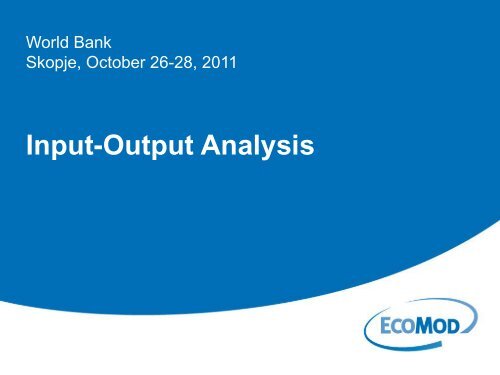
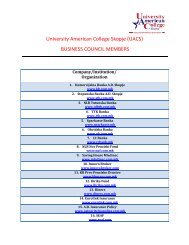

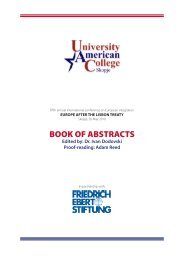

![amerikan kolex ]e bide prv univerzitet od treta generacija vo ...](https://img.yumpu.com/47278343/1/190x252/amerikan-kolex-e-bide-prv-univerzitet-od-treta-generacija-vo-.jpg?quality=85)

